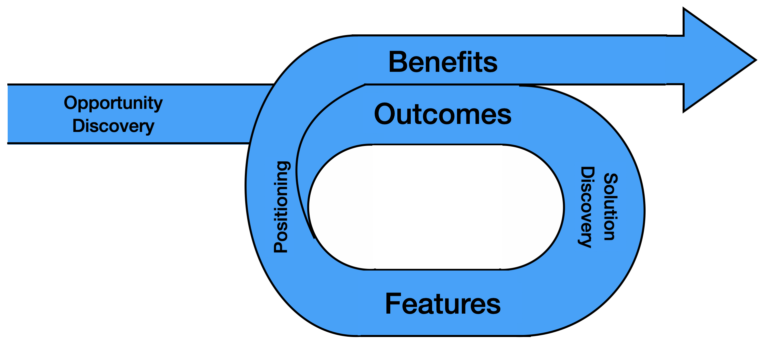Product Management encompasses multiple practices that are often chopped up as you scale an organization. One specific piece that is often split out is the Go-To-Market responsibilities to a role called Product Marketing.
There can be many reasons for this split. What we need to keep in mind is that whenever you split roles up the result will be enabling efficiency along one dimension but decreasing it along another.
Product Marketers seek to define key features and benefits of an offering to the market. This is the mirror image of the outcomes product managers build features to drive.
Close alignment between these product development and marketing activities not only saves time but can drive more efficient feedback loops.
Product Marketing
Product Marketers usually sit in the Marketing or Product organization. In my experience, the larger the organization becomes the more they become disconnected from the product development process. Often, a single product marketer might support multiple products. If they report into the Marketing organization it also adds some additional challenges in optimizing the shared goals of a product team.
One key deliverable Product Marketing is usually responsible is positioning the product in the market. Often they will identify a list of marketable features with product management and use this for positioning analysis within their product category.
What is requested in RFPs?
What features do analysts care about?
What features are our competitors highlighting in their marketing?
This helps them to see what might be important to highlight in their marketing efforts. However, that is just a piece of the puzzle they need to communicate.
To help sell potential customers on the value of their offering, they generally seek to tie the key features to benefits.
Features - Attributes of the product that is usually objective facts.
Examples include: Payments are processed in 10 mins, Reporting tool integrates with MongoDB, complies with GDPR.
Benefits - This is a description of the value that customers get from the product. Often product marketers will connect features to benefits.
Example: Because the application complies with GDPR you are able to use it immediately with your customers in the EU without additional operational workarounds.
Results - Proof points to act as evidence that the benefit is not just theoretically possible but that customers have experienced the stated benefits. Sometimes this is communicated via a case study or customer testimonials.
Example: Customer XYZ switched to our product and was immediately able expand their digital offering to Europe from the US with no legal concerns over GDPR.
Product Management
Better practices in Product Management include planning work around a series of desired outcomes. Product Teams perform discovery work to identify the best solutions they can develop to achieve those outcomes.
Outcomes - Generally some desired change in behavior by a stakeholder that supports customer or business goals.
Example: Enable customers to quickly and confidently do business in markets governed by GDPR.
Features - Whether the product team works in features, capabilities, epics, stories or some other unit of described deliverable -- ultimately they discover and build a solution they believe will achieve the desired outcome.
Examples: Ability to download all user data into a zip file, Ability to be removed from the database, Ability to see how all user data is being used.
Keeping Product Management and Product Marketing Aligned
By ensuring early and continuous alignment between Product Management and Product Marketing the Features, Benefits, and Outcomes can all be aligned.
Features will often be described in more granular terms within the product development process than in marketing. However, there is a clear alignment and both teams should understand terminology being used. This way, product marketing will be able to more readily understand features under-development.
Where the true alignment magic happens is between Outcomes - Benefits. We can argue nuance here, but at a high level these are mirror images of each other. Desired Outcomes are what inspire and guide development. When we talk to the market we describe these as Benefits to derived.
By giving Product Marketing early insight into the Outcomes being solved for, they have a better opportunity to plan for how this can most effectively be communicated. Moreover, they can provide feedback to Product Management that can influence prioritization and scope. This feedback is crucial.
Product Management can frequently get overly focused on existing customer and user perspectives, whereas, product marketing often is looking ahead to future customers.
For Product Marketing, they should never try to analyze the features without input from Product Management on why those features were built -- the Desired Outcomes.
Conclusion
Product Marketing is a function often split from Product Management to enable greater organizational scaling. When split in this way, do not lose the fact that a lot of their work. resolves around the exact same concepts but just seen through a different lens.





